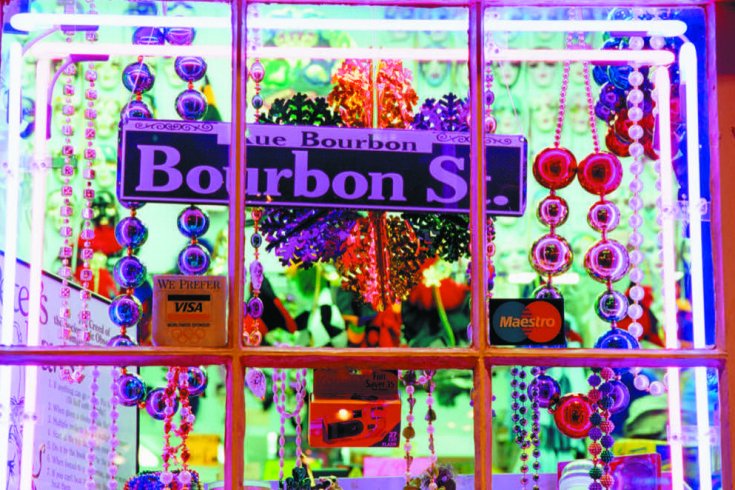
New Orleans—The city of New Orleans’ official tourism website has some stern advice for would-be visitors to its most famous neighbourhood: “The first thing to remember about the French Quarter is that this area is authentic, not a reproduction of history.” This is a bold statement. In an era of theme parks and package tours, authenticity has become the Holy Grail of the tourist experience. It is the duty of the serious journalist to investigate such claims.
The tourist who visits the French Quarter follows a predictable pattern: go in the company of close friends, stay for a short period of time, attain a state of near-permanent intoxication, and above all, avoid other neighbourhoods. If the tourist acting in this manner is promised authenticity, the journalist seeking authenticity must do the same.
And so, an appropriate companion is identified—an oversized, bald, bespectacled and goateed Texan whose long residence in a backward republic of the former Soviet Union has given him the appetites of a bull rhinoceros. A weekend is chosen: a month before Mardi Gras, a time of heightened anticipation. The choice of intoxicant is easy—alcohol, and lots of it.
For almost 300 years, the six-by-thirteen-block French Quarter has been a sweaty, seedy incubator of unique music, great literature, and Creole cuisine. The search for this authentic French Quarter begins, of course, on Bourbon Street, one of the most famously debauched thoroughfares in the modern world. At the corner of Bourbon and Conti, a plaque marks the location of The Old Absinthe House Bar: “From it came the famous Absinthe Drip. The bar where Jean E. Pierre Lafitte, Andrew Jackson, and Mark Twain were served.” An excellent starting point. What could be more authentic than imbibing hallucinogenic cocktails with the ghosts of pirates, presidents, and long-dead authors?
Alas, The Old Absinthe House Bar has been replaced by Mango Mango Pizza and Daiquiris. A row of slush machines behind the bar dispenses coloured ice drinks with names like Smurf in a Blender and The Joker. Further reconnaissance uncovers four different Mango Mango-themed bars within four blocks. The investigation is not going well.
Advancing down Bourbon, a number of “gentlemen’s clubs” are encountered. The Quarter has a long history of bawdy entertainment, and famous strippers like Evangeline the Oyster Girl (1950s burlesque queen Kitty West) are still revered here. The Barely Legal Club’s claim of near-illicit entertainment sounds promising, but hopes are again quickly dashed. Nothing inside the club pushes the outer boundaries of legality. The staff and patrons look on, bored, as a dancer wipes down the brass pole with cleanser before her set.
The final stop of the evening is Lafitte’s Blacksmith Shop, the self-proclaimed “oldest bar in the US,” which was once owned by the pirate Jean Lafitte. As is often the case in the Quarter, the architecture is bona fide—dark wood beams, flagstone floors—but the all-white, middle-American clientele evokes Pirates of the Caribbean at Disney World. Day one ends in disappointment.
Day two goes no better. After hours of wandering aimlessly from bar to bar, the quest seems destined to end in failure back at Lafitte’s, the most authentic (or least inauthentic) discovery to date. Once there, though, a bartender, evidently alarmed that two large, sullen men have consumed his entire stock of Dixie beer in under two hours, suggests a new spot a few blocks away.
Cosimos is reached after a short walk through the foggy night. Inside, dark wood panelling and a long, polished bar create a conspiratorial atmosphere. An attractive young woman strikes up a conversation. Erika, a petite, blond, twenty-one-year-old dancer at the Barely Legal Club, holds Canada in high regard, saying she would live there “if it wasn’t so cold.” Told of the ongoing quest for authenticity, she volunteers to lead the way to the most authentic jazz bar in New Orleans. Finally, an appropriate guide.
The Spotted Cat, on Frenchmen Street, lives up to its billing. A five-piece band fills the tiny room with up-tempo jazz improv. There is no cover; a hat is literally passed to collect tips for the band. The clientele is racially mixed and unmistakably local. It is one of those rare moments of elation for a traveller: a glimpse into the soul of a foreign place.
Erika, her mission accomplished, takes her leave. The long stumble back to the hotel is leavened by the satisfying sense that journalistic rigour has been duly rewarded. But it soon becomes evident that something is terribly wrong: The Spotted Cat is on the wrong side of Esplanade Avenue, unambiguously outside the French Quarter.
The Quarter is quiet on the walk home, until a “jazz” bar is passed where drunken and tone-deaf revellers belt out “Piano Man” at the top of their lungs. This, it seems, is what tourists want the French Quarter to be—not jazz, but Billy Joel; not absinthe, but blended drinks. The quest is over, the claim of authenticity thoroughly debunked. There is much in New Orleans that is authentic, but it is not to be found in the French Quarter.




